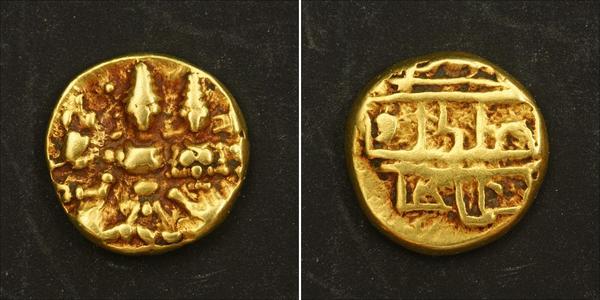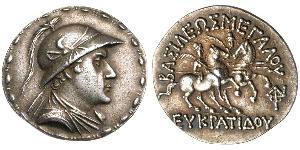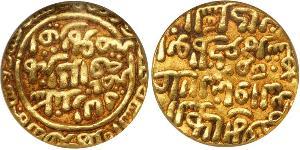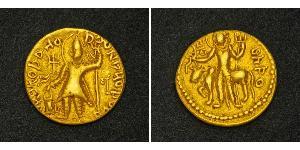(sold for $120.0)
1404, India, Vijayanagar Empire. Nice Gold ½ Pagoda "Shiva & Uma" Coin. 1.65gm!
Country: India Culture: Vijayanagar Empire Mint Period: 1377-1404 AD Denomination: Gold ½ Pagoda Reference: Friedberg 349, Mitchiner 877. R! Condition: Minor deposits in fields, otherwise a well-circulated about VF! Diameter: 10mm Weight: 1.65gm Material: Gold!
Obverse: Śiva and Uma seated facing.
Reverse: Inscription in three lines. in Devanagari. Legend: "śri pra/tapa hari/hara"
Shiva (Śiva), meaning "The Auspicious One" is one of the three major deities of Hinduism. He is the chief deity within Shaivism, one of the three most influential denominations in contemporary Hinduism. He is one of the five primary forms of God in the Smarta Tradition, and "the Transformer".
At the highest level, Shiva is regarded as limitless, transcendent, unchanging and formless. Shiva also has many benevolent and fearsome forms. In benevolent aspects, he is depicted as an omniscient Yogi who lives an ascetic life on Mount Kailash, as well as a householder with wife Parvati and his two children, Ganesha and Kartikeya, and in fierce aspects, he is often depicted slaying demons. Shiva is also regarded as the patron god of yoga and arts.
The main iconographical attributes of Shiva are the third eye on his forehead, the snake Vasuki around his neck, the adorning crescent moon, the holy river Ganga flowing from his matted hair, the trishula as his weapon and the damaru as his musical instrument. Shiva is usually worshiped in the aniconic form of Lingam.
The worship of Shiva is a pan-Hindu tradition, practiced widely across all of India, Nepal, Sri Lanka and parts of Pakistan.
Parvati (Pārvatī) is the Hindu goddess of fertility, love and devotion; as well as of divine strength and power. She is the gentle and nurturing aspect of the Hindu goddess Shakti and one of the central deities of the Goddess-oriented Shakta sect. She is the mother goddess in Hinduism and has many attributes and aspects. Each of her aspects is expressed with a different name, giving her over 100 names in regional Hindu stories of India. Along with Lakshmi (goddess of wealth and prosperity) and Saraswati (goddess of knowledge and learning), she forms the trinity of Hindu goddesses (Tridevi).
Parvati is the wife of the Hindu god Shiva - the destroyer, recycler and regenerator of universe and all life. She is the daughter of the mountain king Himavan and mother Mena. Parvati is the mother of Hindu deities Ganesha and Kartikeya. Some communities also believe her to be the sister of the god Vishnu and the river-goddess Ganga.
With Shiva, Parvati is a central deity in the Shaiva sect. In Hindu belief, she is the recreative energy and power of Shiva, and she is the cause of a bond that connects all beings and a means of their spiritual release. In Hindu temples dedicated to her and Shiva, she is symbolically represented as the argha or yoni. She is found extensively in ancient Indian literature, and her statues and iconography grace Hindu temples all over South Asia and Southeast Asia.
The Vijayanagara Empire referred to as the Kingdom of Bisnagar by the Portuguese, was an empire based in South India, in the Deccan Plateau region. It was established in 1336 by Harihara I and his brother Bukka Raya I. The empire rose to prominence as a culmination of attempts by the southern powers to ward off Islamic invasions by the end of the 13th century. It lasted until 1646 although its power declined after a major military defeat in 1565 by the Deccan sultanates. The empire is named after its capital city of Vijayanagara, whose ruins surround present day Hampi, now a World Heritage Site in Karnataka, India. The writings of medieval European travelers such as Domingo Paes, Fernão Nunes and Niccolò Da Conti, and the literature in local languages provide crucial information about its history. Archaeological excavations at Vijayanagara have revealed the empire's power and wealth.
The empire's legacy includes many monuments spread over South India, the best known of which is the group at Hampi. The previous temple building traditions in South India came together in the Vijayanagara Architecture style. The mingling of all faiths and vernaculars inspired architectural innovation of Hindu temple construction, first in the Deccan and later in the Dravidian idioms using the local granite. Secular royal structures show the influence of the Northern Deccan Sultanate architecture. Efficient administration and vigorous overseas trade brought new technologies such as water management systems for irrigation. The empire's patronage enabled fine arts and literature to reach new heights in the languages of Kannada, Telugu, Tamil and Sanskrit, while Carnatic music evolved into its current form. The Vijayanagara Empire created an epoch in South Indian history that transcended regionalism by promoting Hinduism as a unifying factor.

|
Posted by:
anonymous 2017-09-02 |
2 Florin / 2 Gulden Austria-Hungary (1867-1918) Silver Franz ...
group has 19 coins / 18 prices
⇑
1 Thaler Duchy of Mecklenburg-Schwerin (1352-1918) Silver Fr ...
group has 19 coins / 19 prices
⇑
















-300-150-KgQKX9ISLlMAAAFYVIy668M0.jpg)

-300-150-7BWP8ggt34cAAAFmIusvVi44.jpg)






